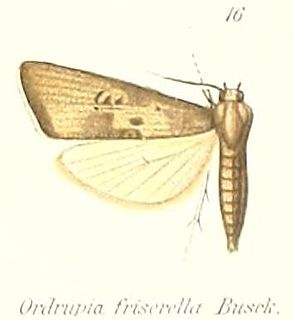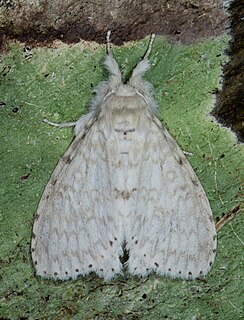Related Research Articles

The Catocalinae are a subfamily of noctuoid moths, placed in family Noctuidae. In the alternative arrangement, where the Noctuidae are reduced to the core group around the Noctuinae, the present lineage is abolished, the upranked Catocalini being merged with the Erebini and becoming a subfamily of the reestablished family Erebidae.

Copromorphidae, the "tropical fruitworm moths" is a family of insects in the lepidopteran order. These moths have broad, rounded forewings, and well-camouflaged scale patterns. Unlike Carposinidae the mouthparts include "labial palps" with the second rather than third segment the longest. With other unusual structural characteristics of the caterpillar and adult, it could represent the sister lineage of all other extant members of this superfamily. The genus Sisyroxena from Madagascar is also notable for its unusual venation and wing scale sockets.
Andesiana is a genus representing its own family Andesianidae and superfamily Andesianoidea, the "Andean endemic moths". It contains three species with a wingspan up to 5.4 cm. in female A. similis and 3.5 cm. in males. This far surpasses in size any previously known monotrysian moth. These large Microlepidoptera are restricted to Andean South America, from where they were described originally in 1989 in the family Cossidae by their discoverer Patricia Gentili.

Hypena is a genus of moths in the family Erebidae. It was first described by Franz von Paula Schrank in 1802. These non-migratory moths overwinter as pupae and almost never come to bait as adults.

Aristotelia is a genus of moths in the family Gelechiidae. Well-known species are food plant specialists, and diverse hosts are used - Salicaceae, Solanaceae, Rosaceae, Fagaceae, Fabaceae, Asteraceae.

Brachmia is a genus of the twirler moth family (Gelechiidae). Among these, it is mostly placed in the subfamily Dichomeridinae.

Hypatima is a genus of the twirler moth family (Gelechiidae). Among these, it belongs to a distinct lineage, which is variously treated as tribe Chelariini in subfamilies Dichomeridinae, Gelechiinae, or even Pexicopiinae, and historically was considered a subfamily in its own right, Chelariinae. Of this lineage, Hypatima – under its junior synonym Chelaria – is the type genus. This genus has numerous species, but its exact limits are not quite clear. This genus occurs mainly in the Southern Hemisphere, though one of the better-known species is the only member of this genus native to Europe, the lobster-clawed moth.

Mesophleps is a genus of moths in the family Gelechiidae. The genus was erected by Jacob Hübner in 1825.

Scoparia is a grass moth genus of subfamily Scopariinae. Some authors have assigned the synonymous taxon Sineudonia to the snout moth family (Pyralidae), where all grass moths were once also included, but this seems to be in error.
Aethalina is a monotypic moth genus in the family Erebidae. Its only species, Aethalina asaphes, is found in Queensland, Australia. Both the genus and species were first described by Turner in 1902.

Dura is a genus of tussock moths in the family Erebidae. The genus was erected by Frederic Moore in 1879.

Macrobathra is a genus of moths in the family Cosmopterigidae. Most species are endemic to Australia.

Oenochrominae is a subfamily of the moth family Geometridae.

Opostega is a genus of moths of the family Opostegidae with 49 listed species.

Epicephala is a genus of moths in the family Gracillariidae.

Cryptoblabes is a genus of small moths belonging to the snout moth family (Pyralidae). They are the type genus of the Cryptoblabini tribe of the huge snout moth subfamily Phycitinae. At least one representative of this genus nowadays occurs in many parts of the world, though this is the result of accidental introductions by humans; most species of Cryptoblabes are fairly restricted in range.

Xyloryctidae is a family of moths contained within the superfamily Gelechioidea described by Edward Meyrick in 1890. Most genera are found in the Indo-Australian region. While many of these moths are tiny, some members of the family grow to a wingspan of up to 66 mm, making them giants among the micromoths.

The Zeuzerinae are a subfamily of the family Cossidae.
Heosphora is a genus of moths in the family Pyralidae. The genus was first described by Edward Meyrick in 1882. The type species is Anerastia psamathella Meyrick, 1879, designated as such by George Hampson in 1901. All Heosphora species are found in Australia.
References
- ↑ Savela, Markku (ed.). "Enchocrana Turner, 1930". Lepidoptera and Some Other Life Forms. Retrieved May 24, 2019.
- ↑ Pitkin, Brian & Jenkins, Paul (November 5, 2004). "Enchocrana Turner, 1930". Butterflies and Moths of the World. Natural History Museum, London . Retrieved October 15, 2020.
| This Oenochrominae moth related article is a stub. You can help Wikipedia by expanding it. |